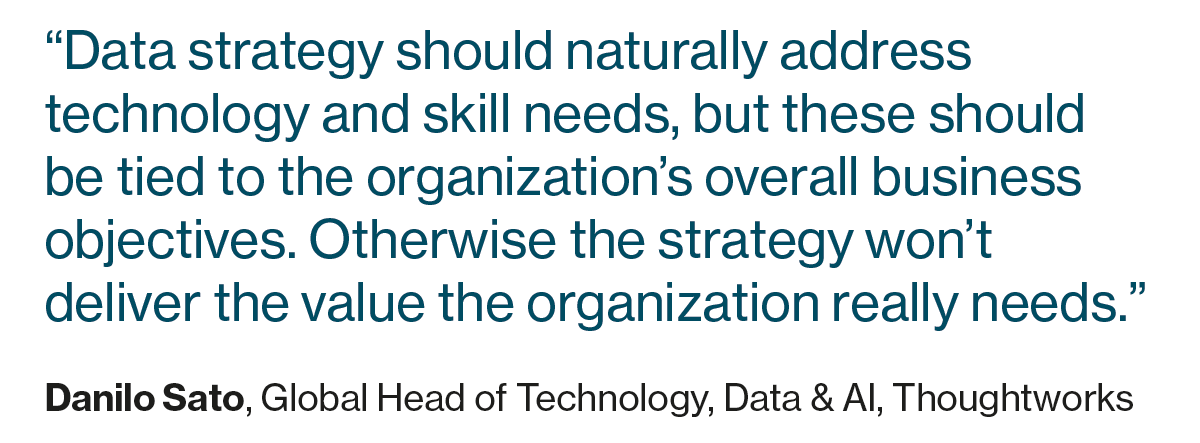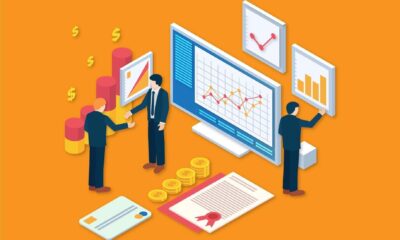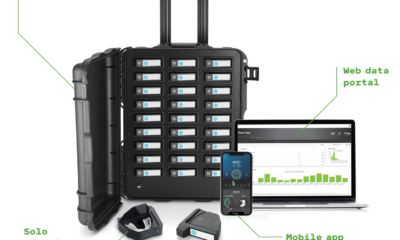Technology & Innovation
3 ways Congress could hold Facebook accountable

By Anjana Susarla and Bhaskar Chakravorti and Ryan Calo—The Conversation 4 minute Read
Let users control more of their data
Anjana Susarla, professor of information systems, Michigan State University
Social media sites like Facebook are designed for constant interaction to engage users’ attention. To rein in Facebook, lawmakers must first understand the harm that results from algorithmic manipulation on these platforms. One thing Congress could do is make sure Facebook gives users more control over what data the company collects about them and why.
Most people who use Facebook are unaware of how algorithmic recommendations affect their experience of the platform and thereby the information they engage with. For example, political campaigns have reportedly tried to manipulate engagement to get more traction on Facebook.
A key aspect of providing such transparency is giving users greater access to and control over their data, similar to what’s proposed in California’s Consumer Privacy Act. This would allow users to see what personal data Facebook collects about them and how the company uses it. Many people don’t realize that Meta has the ability to make inferences about their political preferences and attitudes toward society.
A related issue is data portability tools and rights that allow users to take the data, including photos and videos, that they shared on Facebook to other social media services. Providing users with more control over their data will go a long way in ensuring independent accountability and oversight of Facebook’s operations.
Mandating transparency
Ryan Calo, professor of law, University of Washington
In October 2020, Facebook sent a cease-and-desist letter to New York University researchers who were investigating the spread of misinformation on the site through political ads. The company told NYU that scraping its platform violated Facebook’s terms of service, and it threatened “additional enforcement action” should the practice continue. In August 2021, Facebook terminated the accounts of two researchers and cut off NYU’s and its partners’ access to its political ad repository.
Companies like Meta are not exactly forthcoming about the problems on their platforms. The public hears about issues like misinformation and bias largely through the efforts of researchers, journalists, and internal whistleblowers.
Congress holds the power to stay Meta’s hand when it comes to threatening legal action or blocking accountability research. Congress could, for example, add a research exemption to the Computer Fraud and Abuse Act, which would shield researchers from the threat of lawsuits for using data not explicitly authorized by a social media company, or protect employees from retaliation.
Congress could go further still: It could mandate transparency. Nothing about free speech doctrine or platform immunity prohibits the government from imposing auditing or reporting requirements for social media. The Federal Reserve embeds regulators in national banks. Why shouldn’t Meta—a company with a $900 billion market capitalization and ambitions to spawn a metaverse—have to open its operations to scrutiny?
An alternative approach to making Meta pay
Bhaskar Chakravorti, dean of global business, the Fletcher School, Tufts University
I have a pragmatic suggestion for what the government might do about Meta. When New York Times columnist Farhad Manjoo recently posed this question to experts, they came back with numerous solutions. Ultimately, Manjoo concluded that with the deep political divide in Congress, “doing nothing may be the likeliest outcome.”
I, too, agree it’s the most plausible scenario. Nevertheless, one fact is incontrovertible: Meta is under pressure right now, and the government can use this leverage to extract immediate benefits for society regardless of what happens down the road.
There is a larger problem than Big Tech’s lack of accountability: Almost half of all Americans cannot use the internet at broadband speeds. This is unacceptable in a post-pandemic world, where high-speed internet has proved essential. Broadband internet is also unaffordable for many.
Even the $65 billion earmarked for broadband in the infrastructure bill just approved by Congress isn’t enough to close America’s vast digital divide. My Digital Planet research team at Tufts has estimated that the true cost of closing the infrastructure access gap is $240 billion—leaving a $175 billion shortfall.
Lawmakers could use the stick of regulation to get the company to agree to blanket the nation with broadband. Meta already has two programs it could use to close gaps in both rural and urban areas.
At the same time, Congress could levy a tech tax on digital ads sold by Facebook and other social networks to subsidize telecommunication service in high-cost areas.
By giving more people access to high-speed internet, Meta will benefit by increasing the number of people who could eventually join its metaverse. While that may seem counterproductive, the ills of Facebook are outweighed by the greater ills of large swaths of the U.S. with people unable to use the internet for essential services because we couldn’t raise enough money to close the gap.
Technology & Innovation
How to stop a state from sinking

VIRGINIA HANUSIK
But some government officials and state engineers are hoping there is an alternative: elevation. The $6.8 billion Southwest Coastal Louisiana Project is betting that raising residences by an average of three to five feet and nonresidential buildings by three to six, coupled with extensive work to restore coastal boundary lands, will keep Louisianans in their communities and a local economy that helps power the country’s oil industry running. The project, a collaboration between the US Army Corps of Engineers and the Louisiana Coastal Protection and Restoration Authority (CPRA), is focused on roughly 4,700 square miles of land inthree parishes in the southwestern corner of the state: Cameron, Vermilion, and Calcasieu, where Lake Charles is the parish seat. More than 3,000 homes have been identified as being at risk of imminent flooding, and therefore as candidates for elevation funding.
Ultimately, it’s something of a last-ditch effort to preserve this slice of coastline, even as some locals pick up and move inland and as formal plans for managed retreat—or government funding for community relocation—become more popular in climate-vulnerable areas across the country and the rest of the world.
Since 1932, Louisiana has lost some 1.2 million acres of coast to erosion—an area nearly twice the size of Rhode Island.
Now, after eight years of surveys, paperwork, and waiting for cash, the pilot phase of the project is finally moving forward and raising 21 homes. As it does so, project staff and locals alike will be forced to grapple with a looming existential question: Can a region facing some of the nation’s most alarming climate predictions build its way out of an accelerating crisis?
Darrel Broussard, the project’s senior manager, sees its work as the region’s best chance at reducing damage over the next 50 years and safeguarding the roots residents have put down over generations. “This is Louisiana. This is where everyone lives. This is where we work. This is where the economy comes from,” he says. “There are models out there trying to predict the future. They’re just models. Right now, we currently have communities, neighbors, all living there.”
At the same time, some environmental experts worry that this may be too rosy an outlook, with time and nature conspiring against lasting success. “The sooner we can shift our mindset towards managed retreat, the better,” says Torbjörn Törnqvist, a geology professor at Tulane University. “This is a very tough issue. This is a part of the country that’s just going to disappear.”
It didn’t take long for the Bells to feel at home in Lake Charles, the biggest city in what Louisiana officials call the state’s “working coastline.” The economy here thrives on commercial fishing and agriculture, though petroleum services have long been at its heart; roughly 30% of Louisiana’s refining capacity is based in the region, and the state accounts for nearly one-sixth of the country’s refining capacity, according to the US Energy Information Administration.
But what appealed most to Christa Bell, a public relations professor at McNeese State University, was locals’ hospitality and cuisine—proud reflections of Louisiana’s friendly charm. She loved the warm aesthetic of historic Ryan Street’s red brick buildings, which stand in stark contrast to the city’s casinos and refineries and its single skyscraper, the former Capital One Tower.

VIRGINIA HANUSIK
The building has sat vacant since a hurricane damaged it nearly four years ago—and over that time it has become a symbol of the strain created by severe weather in an area where waterways flow like veins and where flooding occurs often.
Technology & Innovation
Modernizing data with strategic purpose

This report seeks to understand organizations’ objectives for their data modernization projects and how they are implementing such initiatives. To do so, it surveyed senior data and technology executives across industries. The research finds that many have made substantial progress and investment in data modernization. Alignment on data strategy and the goals of modernization appear to be far from complete in many organizations, however, leaving a disconnect between data and technology teams and the rest of the business. Data and technology executives and their teams can still do more to understand their colleagues’ data needs and actively seek their input on how to meet them.
Following are the study’s key findings:
AI isn’t the only reason companies are modernizing the data estate. Better decision-making is the primary aim of data modernization, with nearly half (46%) of executives citing this among their three top drivers. Support for AI models (40%) and for decarbonization (38%) are also major drivers of modernization, as are improving regulatory compliance (33%) and boosting operational efficiency (32%).
Data strategy is too often siloed from business strategy. Nearly all surveyed organizations recognize the importance of taking a strategic approach to data. Only 22% say they lack a fully developed data strategy. When asked if their data strategy is completely aligned with key business objectives, however, only 39% agree. Data teams can also do more to bring other business units and functions into strategy discussions: 42% of respondents say their data strategy was developed exclusively by the data or technology team.
Data strategy paves the road to modernization. It is probably no coincidence that most organizations (71%) that have embarked on data modernization in the past two years have had a data strategy in place for longer than that. Modernization goals require buy-in from the business, and implementation decisions need strategic guidance, lest they lead to added complexity or duplication.
Top data pain points are data quality and timeliness. Executives point to substandard data (cited by 41%) and untimely delivery (33%) as the facets of their data operations most in need of improvement. Incomplete or inaccurate data leads enterprise users to question data trustworthiness. This helps explain why the most common modernization measure taken by our respondents’ organizations in the past two years has been to review and upgrade data governance (cited by 45%).
Cross-functional teams and DataOps are key levers to improve data quality. Modern data engineering practices are taking root in many businesses. Nearly half of organizations (48%) are empowering cross-functional data teams to enforce data quality standards, and 47% are prioritizing implementing DataOps (cited by 47%). These sorts of practices, which echo the agile methodologies and product thinking that have become standard in software engineering, are only starting to make their way into the data realm.
Compliance and security considerations often hinder modernization. Compliance and security concerns are major impediments to modernization, each cited by 44% of the respondents. Regulatory compliance is mentioned particularly frequently by those working in energy, public sector, transport, and financial services organizations. High costs are another oft-cited hurdle (40%), especially among the survey’s smaller organizations.
This content was produced by Insights, the custom content arm of MIT technology Review. It was not written by MIT technology Review’s editorial staff.
Technology & Innovation
Is robotics about to have its own ChatGPT moment?

Stretch weighs about 50 pounds. It has a small mobile base, a stick with a camera dangling off it, and an adjustable arm featuring a gripper with suction cups at the ends. It can be controlled with a console controller. Henry controls Stretch using a laptop, with a tool that that tracks his head movements to move a cursor around. He is able to move his thumb and index finger enough to click a computer mouse. Last summer, Stretch was with the couple for more than a month, and Henry says it gave him a whole new level of autonomy. “It was practical, and I could see using it every day,” he says.
PETER ADAMS
Using his laptop, he could get the robot to brush his hair and have it hold fruit kebabs for him to snack on. It also opened up Henry’s relationship with his granddaughter Teddie. Before, they barely interacted. “She didn’t hug him at all goodbye. Nothing like that,” Jane says. But “Papa Wheelie” and Teddie used Stretch to play, engaging in relay races, bowling, and magnetic fishing.
Stretch doesn’t have much in the way of smarts: it comes with some preinstalled software, such as the web interface that Henry uses to control it, and other capabilities such as AI-enabled navigation. The main benefit of Stretch is that people can plug in their own AI models and use them to do experiments. But it offers a glimpse of what a world with useful home robots could look like. Robots that can do many of the things humans do in the home—tasks such as folding laundry, cooking meals, and cleaning—have been a dream of robotics research since the inception of the field in the 1950s. For a long time, it’s been just that: “Robotics is full of dreamers,” says Kemp.
But the field is at an inflection point, says Ken Goldberg, a robotics professor at the University of California, Berkeley. Previous efforts to build a useful home robot, he says, have emphatically failed to meet the expectations set by popular culture—think the robotic maid from The Jetsons. Now things are very different. Thanks to cheap hardware like Stretch, along with efforts to collect and share data and advances in generative AI, robots are getting more competent and helpful faster than ever before. “We’re at a point where we’re very close to getting capability that is really going to be useful,” Goldberg says.
Folding laundry, cooking shrimp, wiping surfaces, unloading shopping baskets—today’s AI-powered robots are learning to do tasks that for their predecessors would have been extremely difficult.
Missing pieces
There’s a well-known observation among roboticists: What is hard for humans is easy for machines, and what is easy for humans is hard for machines. Called Moravec’s paradox, it was first articulated in the 1980s by Hans Moravec, thena roboticist at the Robotics Institute of Carnegie Mellon University. A robot can play chess or hold an object still for hours on end with no problem. Tying a shoelace, catching a ball, or having a conversation is another matter.
There are three reasons for this, says Goldberg. First, robots lack precise control and coordination. Second, their understanding of the surrounding world is limited because they are reliant on cameras and sensors to perceive it. Third, they lack an innate sense of practical physics.
“Pick up a hammer, and it will probably fall out of your gripper, unless you grab it near the heavy part. But you don’t know that if you just look at it, unless you know how hammers work,” Goldberg says.
-

 Technology & Innovation2 years ago
Technology & Innovation2 years agoHow to get people to help you
-

 Technology & Innovation2 years ago
Technology & Innovation2 years agoWhy are scams getting worse?
-

 Sales & Marketing2 years ago
Sales & Marketing2 years agoVodafone invites Snapchatters to connect with Emma Raducanu virtually
-

 Cryptocurrency2 years ago
Cryptocurrency2 years agoBitcoin price targets 8-week highs as Ethereum reaches $1.8K
-

 Cryptocurrency2 years ago
Cryptocurrency2 years agoAre there too many cryptocurrencies?
-

 Technology & Innovation2 years ago
Technology & Innovation2 years agoHow Log4Shell threatens the Internet
-

 Business & Finance2 years ago
Business & Finance2 years agoHere’s How Apple CEO Earned 500% More In 2021
-

 Business & Finance2 years ago
Business & Finance2 years agoUN Announces Talks To Help Resolve Sudan’s Political Crisis















